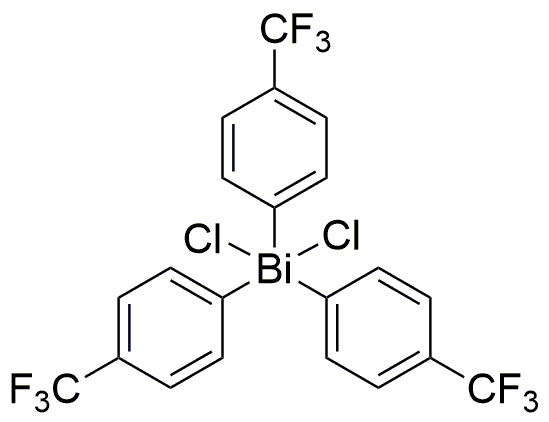Tris(4-trifluoromethylphenyl)bismuth dichloride is widely utilized in research focused on:
- Organic Synthesis: This compound serves as a catalyst in various organic reactions, enhancing reaction rates and yields, particularly in the synthesis of complex organic molecules.
- Pharmaceutical Development: It is employed in the development of new pharmaceuticals, particularly in creating compounds with enhanced biological activity due to its unique electronic properties.
- Material Science: The compound is used in the formulation of advanced materials, such as polymers and coatings, which benefit from its thermal stability and chemical resistance.
- Environmental Chemistry: It plays a role in studies aimed at understanding and mitigating environmental pollutants, especially in the degradation of harmful substances.
- Analytical Chemistry: This chemical is utilized in analytical techniques, such as spectroscopy, to improve the sensitivity and specificity of detection methods for various analytes.
General Information
Properties
Safety and Regulations
Applications
Tris(4-trifluoromethylphenyl)bismuth dichloride is widely utilized in research focused on:
- Organic Synthesis: This compound serves as a catalyst in various organic reactions, enhancing reaction rates and yields, particularly in the synthesis of complex organic molecules.
- Pharmaceutical Development: It is employed in the development of new pharmaceuticals, particularly in creating compounds with enhanced biological activity due to its unique electronic properties.
- Material Science: The compound is used in the formulation of advanced materials, such as polymers and coatings, which benefit from its thermal stability and chemical resistance.
- Environmental Chemistry: It plays a role in studies aimed at understanding and mitigating environmental pollutants, especially in the degradation of harmful substances.
- Analytical Chemistry: This chemical is utilized in analytical techniques, such as spectroscopy, to improve the sensitivity and specificity of detection methods for various analytes.
Documents
Safety Data Sheets (SDS)
The SDS provides comprehensive safety information on handling, storage, and disposal of the product.
Product Specification (PS)
The PS provides a comprehensive breakdown of the product’s properties, including chemical composition, physical state, purity, and storage requirements. It also details acceptable quality ranges and the product's intended applications.
Certificates of Analysis (COA)
Search for Certificates of Analysis (COA) by entering the products Lot Number. Lot and Batch Numbers can be found on a product’s label following the words ‘Lot’ or ‘Batch’.
*Catalog Number
*Lot Number
Certificates Of Origin (COO)
This COO confirms the country where the product was manufactured, and also details the materials and components used in it and whether it is derived from natural, synthetic, or other specific sources. This certificate may be required for customs, trade, and regulatory compliance.
*Catalog Number
*Lot Number
Safety Data Sheets (SDS)
The SDS provides comprehensive safety information on handling, storage, and disposal of the product.
DownloadProduct Specification (PS)
The PS provides a comprehensive breakdown of the product’s properties, including chemical composition, physical state, purity, and storage requirements. It also details acceptable quality ranges and the product's intended applications.
DownloadCertificates of Analysis (COA)
Search for Certificates of Analysis (COA) by entering the products Lot Number. Lot and Batch Numbers can be found on a product’s label following the words ‘Lot’ or ‘Batch’.
*Catalog Number
*Lot Number
Certificates Of Origin (COO)
This COO confirms the country where the product was manufactured, and also details the materials and components used in it and whether it is derived from natural, synthetic, or other specific sources. This certificate may be required for customs, trade, and regulatory compliance.


